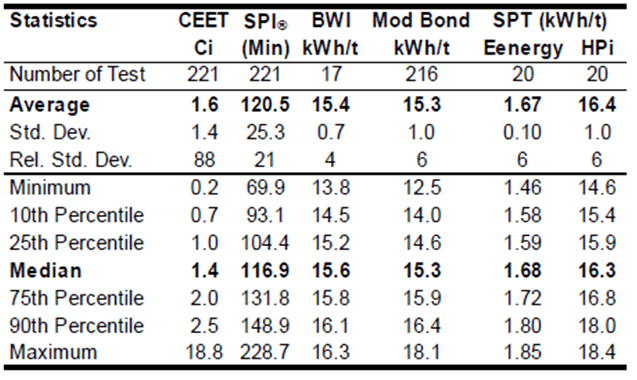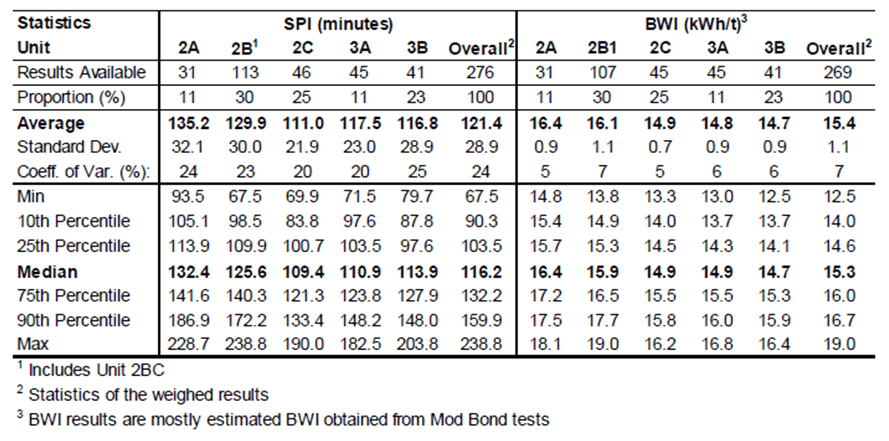- To participate in the 911Metallurgist Forums, be sure to JOIN & LOGIN
- Use Add New Topic to ask a New Question/Discussion about Grinding.
- OR Select a Topic that Interests you.
- Use Add Reply = to Reply/Participate in a Topic/Discussion (most frequent).
Using Add Reply allows you to Attach Images or PDF files and provide a more complete input. - Use Add Comment = to comment on someone else’s Reply in an already active Topic/Discussion.
Modified Bond Ball Mill Work Index Test - What is this? (5 replies)
Hi Josh,
a modified Bond ball mill procedure (Mod Bond) was developed by MinnovEX Technologies (now SGS) which requires 1.2kg of sample crushed at minus 3.35mm. The 1.2kg charge is milled with the standard Bond ball mill for a set time. A particle size analysis is performed on the feed and ground product, and a modified work index is calculated using a proprietary model. The Mod Bond results must be calibrated against sufficient standard Bond ball mill work indices, typically 10% of the total.
The Mod Bond test is used for large variability programs because it provides significant savings in terms of costs
(less material required and testing time) and turnaround time, without jeopardising the quality of the results. Because it is not closed with a given sieve, the test can be used to simulate any closing screen, which is very useful when large datasets with variable target grinds are considered, and/or when the exact final grinds have not been established. (this is copy/paste from the SGS PDF on website).
It’s cheaper because you only run the ball mill once – it needs to be calibrated to a real bond test and the model to calculate the BWi from the test is proprietary = "the procedure is a secret" LOL
It is as good as Bond? Apparently (SGS) if applied to a large number of samples. Tested truth or just marketing: I don't know myself (never used/tried).
Let's wait for the knowledge base to express itself and others to please jump in.
Example Case:
The Thirty-nine samples were submitted for the Crusher Index (Ci), SAG Power Index (SPI®), Standard Bond Ball Mill Work Index (BWI) and Modified Bond Ball Mill work Index (MBI) tests.
The Ci, SPI® and Bond Wi values of these samples show a good indication of ore hardness variability within the ore body. The samples were characterized as hard ore from the perspective of semi-autogenous milling with the average Ci of 4.2 and SPI® of 142.7 minutes. The samples were characterized as relatively hard ore in terms of ball milling with an average of 16.7 kWh/t.
A total of 221 variability samples from the Lac Otelnuk deposit were submitted for a grindability characterization study which involved the SPI® and the modified Bond ball mill grindability (Mod Bond) tests. Standard Bond ball mill grindability test and SPT were conducted on a limited amount of samples (up to 20). The main grindability statistics from this project are summarized in Table 1, which assumed an equal weight for each sample.

The samples tested were primarily classified as moderately hard to hard in terms of the SPI® test, averaging 120.5 minutes. Standard Bond ball mill grindability tests and calibrated Mod Bonds, using a closing screen of 270 mesh (53 microns), classified most samples as medium to moderately hard and averaged 15.3 kWh/t (Mod Bond only). The SPT locked-cycle high pressure indices (HPi) ranged from 14.6 kWh/t to 18.4 kWh/t averaging 16.4 kWh/t.
The results showed that units 2A and 2B are harder than the other units in the deposit. Units 2C, 3A and 3B depicted similar statistics in terms of hardness variability. The overall weighed average was 121.4 minutes in terms of SPI® and 15.4 kWh/t in terms of BWI. With an overall coefficient of variability of 24%, the hardness variability was medium with respect to SPI®, while it was very low with respect to BWI (7%).

reading this may help you https://www.911metallurgist.com/mod-bond-modified-bond-work-index-test-results-report/
Use the Social Share Bar on the Left. Tell everyone you can about https://www.911metallurgist.com/metallurgy/ It's FREE & GOOD.
Hi Josh and David,
There is also a JKTech Bond Ball Mill Work Index Light. Basically only does the BBMWI to 3 cycles instead of the steady state. Requires less material ie 3kg, costs less even if you do duplicates. Apparently based on their data base data they have an average error of 4% compared to 3.5% for the full BBMWI.
Regards,
Chris
Hi all, just gave a presentation on this in December at the geomet conference, here is a synopsis (to complement DAvid and Chris's answer).
As David points out, the premise is that the standard Bond test requires 8+ hours to run a single test so from the perspective of output per unit time, it is very inefficient and therefore undesirable for large geometallurgy projects where you need hundreds or thousands of tests in order to be able to use spatial or geostatistical modeling methods. So for many years people have been trying to come up with more efficient methods, and the Minnovex and JKTech methods listed above are only just a few of them.
In my paper we classified them into four categories based on the approach. These are:
- Comparative methods, such as that proposed by Berry and Bruce (1966), in which simple batch tests are performed in the Bond mill and a reference ore, for which a complete Bond work index is available, is used as a calibration point.
- Empirical methods, in which a batch test is conducted (sometimes in nonstandard Bond mills; i.e. wet laboratory mills) and a simple empirical equation is derived using regression methods and a database of ores that have been tested both ways. Examples are the MinnovEX approach, also Smith & Lee (1968).
- Fenomenalogical methods, in which the breakage and selection functions of an ore are measured (usually with the standard Bond mill), a classifier model is introduced (to simulate the closing screen), and the Bond locked cycle test (the standard test) is simulated mathematically. Examples: Kapur (1970), Karra (1981), Yap et al. (1982), Aksani & Sonmez (1999), and others.
- "Short" Methods, such as the JKTech approach, in which only the first one or several cycles of the standard Bond test are conducted and the Bond work index is calculated (usually empirically) from the results.
The key point to choosing an approach is to understand the sources of error and how they propagate from test to calibration to geometallurgy. The JKTech method has shown to have the lowest error of the various published methods, but this is expected because the feed size distribution and feed mass of the "short" test were identical to that of the standard test (because to develop the calibration, they simply used the first three cycles of a standard test and did not actually repeat the short test independently).
Using this principal (of not repeating the sample prep independently for the standard and short test, and therefore segregating the preparation error from the calibration error), we designed a new Bond test, called the MiniBond, which has an error of approximately 3.1%. The MiniBond test requires about 600g of sample and, unlike the JKTech method, can be calibrated to multiple closing screen sizes (i.e. if you change your grind size, you don't have to redo all the tests, just redo the calibration).
In both cases (MiniBond and JK Bond Lite) the calibration error of the "Short" test is negligible compared that of the standard Bond test.
Attaching a PDF copy of the presentation; sorry it's in a Spanish but you will get the idea from the tables and figures.
Cheers, Pete
The Bond test procedure discussed in the 1985 SMC Handbook (Section 30 page 65) includes a modification to deal with feeds that contain excess fines (e.g. clayey ores). The feed to the first cycle is passed through the closing screen to remove finished product and the oversize is charged to the mill. Revolutions for the first cycle are set to zero. Subsequent charges per cycle are not pre-screened. I have used this test numerous times and it correlates well to plant trials. I wonder if this is what Josh Wright was actually referring to?
Hi Dave, Peter, Chris, and Greg,
Firstly, thank you so much for taking the time to reply. One of my colleagues mentioned that a recent RFQ requested a modified bond ball mill work index. We had suspected that it was some sort of proprietary method. You have confirmed our suspicions. Thanks again for the replies, your information was extremely helpful.
Cheers,
Josh

How does a "modified bond ball mill work index" test vary from a standard ball mill work index test?